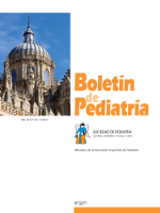Uso de la ecografía en la comprobación de la intubación traqueal urgente en pediatría: experiencia preliminar
M. Mora Matilla , I. Oulego Erroz , P. Alonso Quintela , S. Gautreaux Minaya , D. Mata Zubillaga , S. Rodríguez Blanco
Bol. Pediatr. 2012; 52 (221): 152 - 159
Introducción y objetivos. El método estándar para la confirmación de la intubación traqueal es la laringoscopia directa; siendo el método secundario más recomendado la capnografía. Por otro lado, existe un interés creciente en el uso de la ecografía como técnica alternativa y complementaria, con la ventaja añadida de permitir comprobar los movimientos respiratorios, sin embargo, su uso es aún limitado. Exponemos nuestra experiencia preliminar con el uso de la ecografía para este fin, describiendo e ilustrando la técnica en una pequeña serie de pacientes. Material y métodos. Se comprobó la intubación correcta en los planos longitudinal y transversal así como la ausencia de intubación bronquial selectiva mediante ecografía. Posteriormente un segundo investigador revisó y analizó las imágenes obtenidas para evaluar la concordancia entre ambos. Casos clínicos. Fueron incluidas 7 intubaciones en 5 pacientes, sin producirse en ningún caso intubación esofágica. La mediana del tiempo de comprobación fue 63,5 (28-97,5) segundos. La posición del tubo fue considerada como correcta ecográficamente en 6 de los casos, según el signo del lung sliding y la motilidad diafragmática; sin embargo, por radiografía convencional sólo se consideró correcta en 5. En 27 de las 28 imágenes registradas hubo concordancia entre ambos investigadores.
Use of ultrasonograph in the verification of urgent tracheal intubation in pediatrics: preliminary experience
Introduction and objectives. Direct laringoscopy is the standard method to confirm proper endotracheal tube placement; capnography represents the second most recommended method. Nowadays, ultrasound is gaining interest as an alternative and complementary technique, which also allows the comprobation of respiratory movements. Unfortunately this use is still limited. This study aimed to show our experience with the use of ultrasound for this purpose, describing and illustrating the technique in a small series of patients.
Material and methods. Proper intubation in longitudinal and transverse plane, as well as the absence of selective bronchial intubation was verified by ultrasound. Subse-quently the obtained images were reviewed and analyzed by a second researcher to evaluate the correlation between them.
Clinical cases. Seven intubations in five patients were included, none of them were esophagical. The average time to verify was 63.5 (28-97.5) seconds. Correct tube position was considered by ultrasound lung sliding and diaphragmatic motility in 6 cases, in contrast with 5 cases by conventional radiography. In 27 of 28 recorded images there was an agreement between both researchers.
Artículo completo (PDF) (156 kb.)
- Urgencias/UCIP
